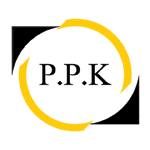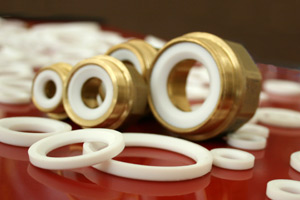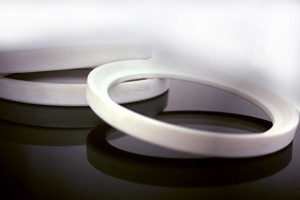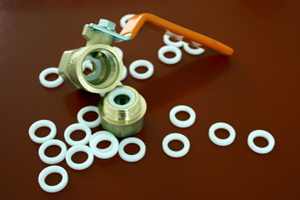
As a subset of industrial energy control Sama
More than 10 years, is active in producing PTFE parts.
The strategic component, which is the result of years of research and engineering departments of the company, In many industries, such as mother, petrochemical, automotive, aerospace and ... Is used.
We now have the honor as the first manufacturer of these parts of Iran, Teflon provider for many industries of the country, especially our colleagues in the valve industry.
Polytetrafluoroethylene (PTFE) is a synthetic fluoropolymer of tetrafluoroethylene that finds numerous applications. PTFE is most well known by the DuPont brand name Teflon.
PTFE is a fluorocarbon solid, as it is a high-molecular-weight compound consisting wholly of carbon and fluorine. PTFE is hydrophobic: neither water nor water-containing substances wet PTFE, as fluorocarbons demonstrate mitigated London dispersion forces due to the highelectronegativity of fluorine. PTFE has one of the lowest coefficients of friction against any solid.
PTFE is used as a non-stick coating for pans and other cookware. It is very non-reactive, partly because of the strength of carbon–fluorine bonds, and so it is often used in containers and pipework for reactive and corrosive chemicals. Where used as a lubricant, PTFE reduces friction, wear, and energy consumption of machinery.
It is commonly believed that Teflon, like Velcro, is a spin-off product from the NASA space projects. However, that is not so, even though both products have been used by NASA



PTFE was accidentally invented by Roy Plunkett of Kinetic Chemicals in New Jersey in 1938. While Plunkett was attempting to make a new CFC refrigerant, the tetrafluoroethylene gas in its pressure bottle stopped flowing before the bottle's weight had dropped to the point signaling "empty." Since Plunkett was measuring the amount of gas used by weighing the bottle, he became curious as to the source of the weight, and finally resorted to sawing the bottle apart. Inside, he found it coated with a waxy white material which was oddly slippery. Analysis of the material showed that it was polymerized perfluoroethylene, with the iron from the inside of the container having acted as a catalyst at high pressure. Kinetic Chemicals patented the new fluorinated plastic (analogous to known polyethylene) in 1941[2] and registered the Teflon trademark in 1945.
An early advanced use was in the Manhattan Project as a material to coat valves and seals in the pipes holding highly reactive uranium hexafluoride at the vast K-25 uranium enrichment plant at Oak Ridge, Tennessee.
DuPont, which founded Kinetic Chemicals in partnership with General Motors, was producing over two million pounds (900 tons) of Teflon per year in Parkersburg, West Virginia, by 1948.
In 1954, French engineer Marc Grégoire created the first pan coated with Teflon non-stick resin under the brand name of Tefal after his wife urged him to try the material he had been using on fishing tackle on her cooking pans. In the United States, Kansas City, Missouri resident Marion, who had been using the substance on scientific utensils, marketed the first US-made Teflon coated frying pan, "The Happy Pan," in 1961.
More than 10 years, is active in producing PTFE parts.
The strategic component, which is the result of years of research and engineering departments of the company, In many industries, such as mother, petrochemical, automotive, aerospace and ... Is used.
We now have the honor as the first manufacturer of these parts of Iran, Teflon provider for many industries of the country, especially our colleagues in the valve industry.
| Properties | |
| Molecular formula | (C2F4)n |
| Density | 2200 kg/m3 |
| Melting point | 327 °C |
| Thermal conductivity | 0.25 W/(m·K) |
Polytetrafluoroethylene (PTFE) is a synthetic fluoropolymer of tetrafluoroethylene that finds numerous applications. PTFE is most well known by the DuPont brand name Teflon.
PTFE is a fluorocarbon solid, as it is a high-molecular-weight compound consisting wholly of carbon and fluorine. PTFE is hydrophobic: neither water nor water-containing substances wet PTFE, as fluorocarbons demonstrate mitigated London dispersion forces due to the highelectronegativity of fluorine. PTFE has one of the lowest coefficients of friction against any solid.
PTFE is used as a non-stick coating for pans and other cookware. It is very non-reactive, partly because of the strength of carbon–fluorine bonds, and so it is often used in containers and pipework for reactive and corrosive chemicals. Where used as a lubricant, PTFE reduces friction, wear, and energy consumption of machinery.
It is commonly believed that Teflon, like Velcro, is a spin-off product from the NASA space projects. However, that is not so, even though both products have been used by NASA



PTFE was accidentally invented by Roy Plunkett of Kinetic Chemicals in New Jersey in 1938. While Plunkett was attempting to make a new CFC refrigerant, the tetrafluoroethylene gas in its pressure bottle stopped flowing before the bottle's weight had dropped to the point signaling "empty." Since Plunkett was measuring the amount of gas used by weighing the bottle, he became curious as to the source of the weight, and finally resorted to sawing the bottle apart. Inside, he found it coated with a waxy white material which was oddly slippery. Analysis of the material showed that it was polymerized perfluoroethylene, with the iron from the inside of the container having acted as a catalyst at high pressure. Kinetic Chemicals patented the new fluorinated plastic (analogous to known polyethylene) in 1941[2] and registered the Teflon trademark in 1945.
An early advanced use was in the Manhattan Project as a material to coat valves and seals in the pipes holding highly reactive uranium hexafluoride at the vast K-25 uranium enrichment plant at Oak Ridge, Tennessee.
DuPont, which founded Kinetic Chemicals in partnership with General Motors, was producing over two million pounds (900 tons) of Teflon per year in Parkersburg, West Virginia, by 1948.
In 1954, French engineer Marc Grégoire created the first pan coated with Teflon non-stick resin under the brand name of Tefal after his wife urged him to try the material he had been using on fishing tackle on her cooking pans. In the United States, Kansas City, Missouri resident Marion, who had been using the substance on scientific utensils, marketed the first US-made Teflon coated frying pan, "The Happy Pan," in 1961.
